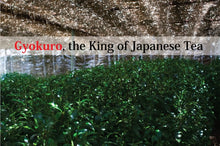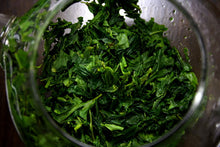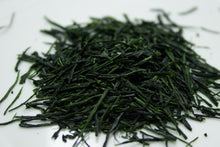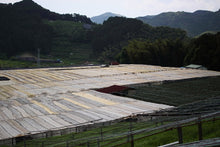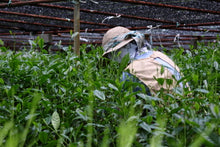
This Yame Gyokuro is produced in Fukuoka. It has a sweet nutty note and a thick umami lingering taste.
 Have you ever heard of the tea called “Gyokuro”?
Have you ever heard of the tea called “Gyokuro”?
The direct translation in Japanese for Gyokuro is “Dew of Jade” (玉露) and it is such a fabulous name. This tea is not a common tea in Japan. It is so rare that many Japanese themselves never had a chance to drink this tea before in their life.
 |
 |
|
| Gyokuro | The leaf of Gyokuro is very vivid green |
If you go to a Japanese restaurant, they normally serve so-called “Ocha”. Ocha means “tea” in Japanese. Usually the type of tea served in Japanese restaurant is common sencha.
As for Gyokuro, its flavor is very different from sencha. Gyokuro reminds us of fresh seaweed or milky flavor in addition to the fresh leafy flavor of green tea. This particular flavor is made thanks to a very unique cultivating technique.
As a matter of fact, Gyokuro is not the name referring to a specific type of tea cultivar or a particular process that is used to produce it. The same type of tea cultivar such as “Yabukita” is used for both Sencha and Gyokuro. The process of making Gyokuro is almost the same as the one for making sencha as well. The secret of Gyokuro exists in its tea garden. The tea garden is completely under the shade. The garden is fully covered by sheets to block out direct sunshine. The tea trees receive less sunshine due to the sheets. The frame is constructed on top of tea garden and the sheet is placed over the frame. The Gyokuro garden looks like a warehouse or a military base.
 |
 |
|
| The tea garden of Gyokuro is fully covered. It looks like a warehouse. | Gyokuro is usually plucked by hand |
When tea tree receives less sunshine, tea tree will have to make an effort for survival. Firstly, the tea leaves increase in size in order to absorb more sunshine. Secondly, the tea leaves increases the number of green pigment that is called chlorophyll. With more chlorophyll, the more efficient the tea leaves can carry out photosynthesis. In addition, a lot of nutrients that has been stored since when tea leaf was young are not consumed and remained in the tea leaf. This is how Gyokuro with its distinctive flavor is produced.
Cold Water Brewing
You can brew Gyokuro in cold water as well, as its leaf is very delicate. All you need to do is to place a small quantity of tea leaf in a PET bottle or a glass bottle, then pour some drinking water and keep in refrigerator. Tea is ready within 1 hour. Being kept in the refrigerator, the quality of cold-water brewed Gyokuro remains fresh even up to a few days.
It is also ordinary practice to eat the brewed leaf of Gyokuro. The leaves are so delicate and tender. I know many customers who enjoy eating brewed Gyokuro leaf with porridge, salad or risotto.





